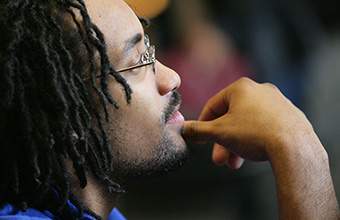College of Arts and Sciences Newsroom

Boosting Student Retention Rates
The University of Dayton has seen a nearly 8 percent increase in student retention rates after launching a course to provide undeclared first-year students with skills and resources for academic success.
The First Year Seminar for Discovering Students was created through collaboration among the College of Arts and Sciences’ academic departments and dean’s office to best support the needs of undeclared first-year students, or students who have yet to choose a major.
The Discover Arts and Sciences course, ASI 160, focuses on skills students need to learn during their first semester at the university level, such as how to write professional emails, approach instructor office hours and take advantage of campus resources.
The course is one of the reasons the retention rate for the University’s undecided students in the College of Arts and Sciences increased by 7.7 percent, according to data collected and analyzed by the College.
Significant changes to the Discovering Students program were implemented starting in 2012. The Discover Arts and Sciences course was expanded to a two-day-per-week class and renumbered as ASI 160 in fall 2015.
Those changes have contributed to increasing the retention rate of first- to second-year students to 85.6 percent, up from an average of 78.8 percent during the five years before the course was created. These numbers reflect students who entered the University in the College as undecided.
Aaron Witherspoon, College assistant dean for student success and student academic affairs, credits much of the success to the faculty and teaching assistants who work with students to help them succeed.
Research shows that students who are undeclared are at a higher risk for leaving the University in comparison to peers who have chosen a major.
“We know through literature and research that the more positive interactions first-year students have with faculty and staff, the more likely they are to be successful,” Witherspoon said. “We made the decision to design this course as a two-day-per-week class with that knowledge in mind.”
Discover Arts and Sciences instructors also serve as academic advisors until the student declares a major. This allows an undeclared student to build a relationship with a faculty member who understands his or her goals and can provide needed support.
“This course really helps first-year students find their way at the University,” said Tom Morgan, associate professor of English. “Everyone when they come into a new setting needs guidance and it’s my job as an ASI instructor to be the person who helps them find answers.”
The College dean’s office allocates resources to allow Discover Arts and Sciences instructors to have an undergraduate teaching assistant with them in the classroom.
“I think our teaching assistants have played a huge role in making this course successful,” Witherspoon said. “The first-year students feel comfortable asking the undergraduate teaching assistants questions that they may be apprehensive asking faculty. The teaching assistants have really served as mentors for the students as opposed to just being another authority figure in the classroom, which has been a tremendous help.”
Teaching assistant Marissa Jama, a senior biology major from Downers Grove, Illinois, has seen the benefits of guiding first-year students during their first semester.
“I had such a positive experience with the ASI course I took my first year, and felt that being a teaching assistant for the ASI 160 course would be a great way to spend time during my senior year,” Jama said. “The purpose of the course is to connect these students with all of the resources UD has to offer, and I was excited to have the opportunity to help with that process.”
The course aligns well with the mission and strengths of the University by allowing students to build skills, while simultaneously building relationships that will help them throughout their time studying at the University.
“One of the strengths of the University of Dayton is the relationships people build and I think that helps us in building a successful discover program,” Witherspoon said. “We’re able to build strong relationships between faculty and students, we’re able to build the leadership skills of our undergraduate teaching assistants, and our curriculum is flexible, allowing students to explore what they would really like to do while still being on pace to graduate.”
- Alex Burchfield ’16, communication assistant, College of Arts and Sciences
